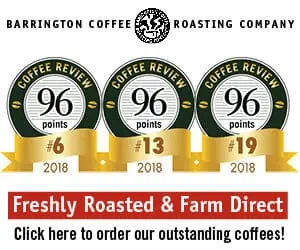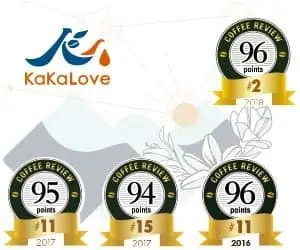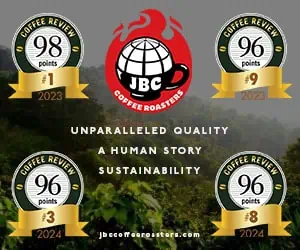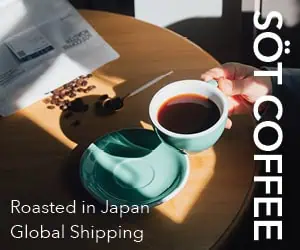Neither recent history nor recent coffee books have been kind to El Salvador.
In 1976 I wrote in the first edition of Coffee: A Guide to Buying, Brewing & Enjoying: “The general consensus is El Salvador coffee has a flavor somewhere between ‘neutral’ and ‘mild.'” Twenty years later Jon Thorn in The Coffee Companion calls El Salvador coffee “balanced, if not distinctive.” Between lies a trail of similar patronizations, evasions and faint praise from twenty years of coffee describers and writers.
So the question posed by this blind panel cupping of eleven El Salvador coffees is: Should this sort of judgement be revised? Have we all been making a casual, self-perpetuating assumption based on half knowledge or prejudiced palates? Panelist Kevin Knox apparently thinks we are: In Allegro Coffee’s Spring 1997 newsletter Coffee Chronicles he writes admiringly of the estate coffees of El Salvador, citing their “balanced and sweet cup profile … and consistently flawless processing.”
Certainly things have changed in El Salvador, which over the past twenty years went from one of the world’s major producers of coffee (fourth largest in 1978/79) to an also-ran eleventh after twelve years of civil war weakened the industry and its social and technical underpinnings. Now, with peace precariously re-established, some El Salvador producers and exporters are attempting to take advantage of a possibility that barely existed in the heyday of El Salvador coffee, the market for “estate” or limited origin coffees. Itzalco, a project originally funded by the European Community, attempts to reposition El Salvador as a distinguished coffee origin by creating a special market for coffees of selected cooperatives and estates that meet exacting Itzalco criteria in regard to altitude and grading standards. All of the coffees in this cupping are Itzalco coffees except the Don Hilario.
The word estate may provoke unfortunate visions of neo-aristocrats sprawling indolently on verandas. In fact, several of the Itzalco coffees in the cupping come from cooperatives of small growers, others from cooperatives of larger growers, and only a few are the produce of solely-owned farms, where I expect there is too much work to do to allow for much veranda-sprawling. Nevertheless, all are “estate” coffees as the specialty business uses the term today: They derive from a limited and specific growing area, from a single crop, and are processed at the same mill using similar procedures.
El Salvador estates and cooperatives may even — in theory — claim an edge over some of their counterparts elsewhere in Latin America. The recent civil war discouraged the technification of coffee growing in El Salvador. In particular, it discouraged dissemination of the various high-yielding, sun-grown hybrid varieties of coffea arabica that now dominate in parts of Costa Rica and Colombia. These hybrid “new arabicas” are, of course, viewed with suspicion by North American coffee professionals, who tend to prefer traditional, shade-grown “old arabica” varieties like var. bourbon, a classic cultivar which continues to make up about 80% of El Salvador’s production.
Nevertheless, the two highest ranking coffees in this month’s cupping both came from trees of a “new” hybrid variety, var. pacamara. And one of the two pacamaras, from the Larin estate, ranked five points higher than a var. bourbon from the same farm.
Furthermore, the pacamara, with its large, bold bean, is a cross between two arabica varieties not much admired for their flavor: the compact, high-bearing var. caturra and the maragogipe, an “old arabica” grown more for its enormous bean size than for its often thinnish, lackluster flavor. Despite its dubious parentage, the two high-grown pacamaras in the cupping produced a coffee both striking in appearance and sufficiently distinctive in character to dominate the ratings.
So how do all of these new, or revived, estate coffees from El Salvador fare when subjected to blind tasting by ten American coffee professionals plus one professional coffee writer?
Not bad, not great. If we stick to numbers, the average overall rating for these eleven El Salvadors was 74, whereas the nine Guatemalas reviewed in the January 1998 issue averaged 78. More significant to my way of thinking is the absence here of the excitement that ran through the comments on the best of the Guatemalas, particularly the highest-rated La Tacita.
If we read the comments on the cupping forms a clear El Salvador profile emerges: light-to-medium body, an ingratiating softness and sweetness, together with attractive fruit notes in the higher registers. One cupper consistently admired this profile; a couple of others found it consistently uninspiring; the rest picked their spots without getting carried away.
Nor are these coffees as free of defect as one might hope. Although only the non-Itzalco Don Hilario showed clear signs of defect, several of the estate coffees hinted at problems.
Nevertheless, there is potential here. It would be interesting to do a blind cupping in which we set the best of these El Salvador coffees on the table against more celebrated coffees with similarly soft, medium-bodied profiles; against Hawaiian Konas for example. I would predict that many North American cuppers, who tend to prefer coffees with authoritative, acidy profiles, might describe the Konas in the same rather patronizing terms used here to describe the understated virtues of the best of these El Salvadors.










